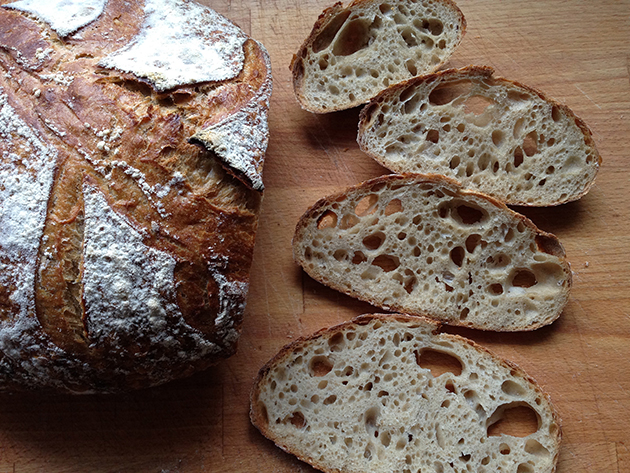Sourdough Amaretto variety stoneground 9% protein

This sourdough made with white stoneground flour milled in Wales by my friend Anne is an amaretto wheat variety grown not far from me in Harpenden by a charismatic farmer called Howard Roberts. This batch of amaretto flour is particular low in protein, around 8.9%, because the harvest in 2013 wasn’t very kind especially to organic farmers.
Search this site for other posts on amaretto flour. This flour is worth seeking out because it has the most delicious interesting flavour and best of all if you are like me and value a good flavoursome crust, well, it produces the best crust both in terms of its flavour profile and also aesthetically speaking with a well pronounced rip, from the later than usual rise during baking.
It is not easy to find this variety to buy because the few people who grow it will often sell it to mills who will then blend it with other stronger flours in order to be more acceptable for modern day bakers and their machines and kneading methods. If baking at home for you is about baking with flavoursome flours then white stoneground amaretto should be on your ‘must try’ list.
The paragon wheat variety is more widespread in the organic flour market but I would not recommend it as far as flavour is concern because it is dull in comparison to either the amaretto or the now extinct tybalt variety I’ve often written about here. The only thing paragon has going for it as far as I can see is its ability to produce a higher protein flour in our erratic climate.
This loaf is made with all white amaretto (except for the levain) and has 75% hydration. Here are my notes and thoughts:
- Left it to rise til max capability, it was ripping all over the surface of dough
- Dough had more potential to rise, was very bubbly and full of gas activity but the weaker protein just wasn’t allowing any more rise as surface tearing indicated
- The crumb is perfect with good mouthfeel and enough aeration but given this dough is 75% hydration at such low protein I am surprised how tight the crumb is.
- For this low protein I was expecting more of an open crumb which makes me question what’s going on with this flour?
- Stoneground flour is at the mercy of its simple sieving method (in-between flour, aleurone fractions comes to mind)
- I also need to think about the fractions of the starch granules with this low protein, need to refer back soft/hard wheat principals on starch fractions and the milling of it, does it apply when the hard wheat variety has a bad protein year? genetics or environmental?
- Last week when I made same loaf the ‘cooling’ period of the dough helped with the enzyme activity/strengthening of gluten.
The amaretto loaf below made the same as the one above with the same batch of flour but at 80% hydration



